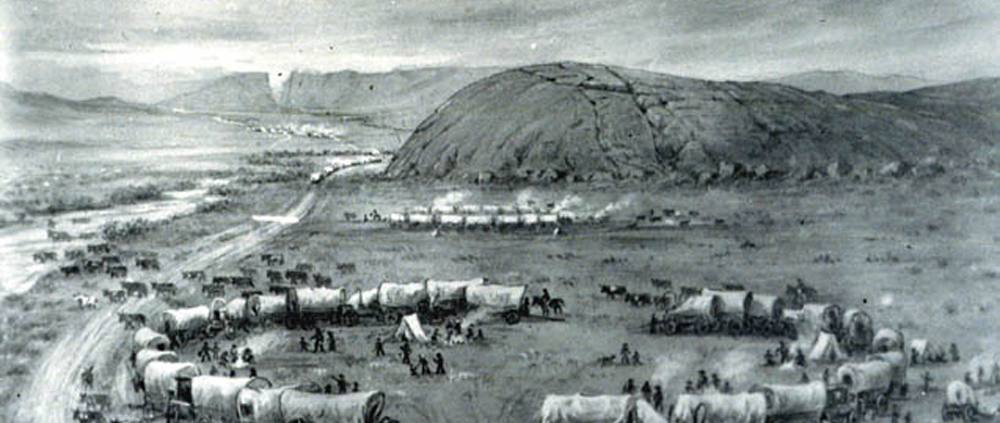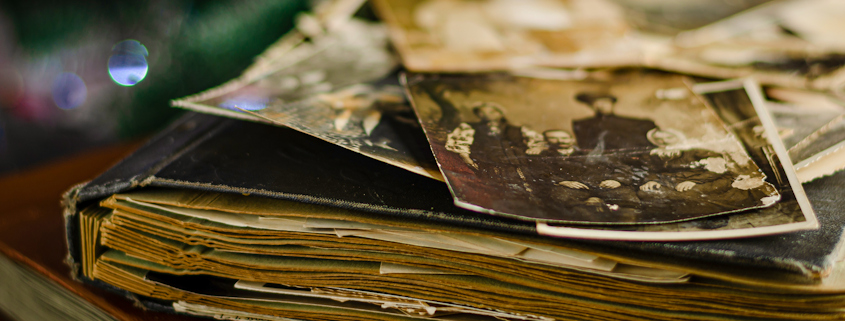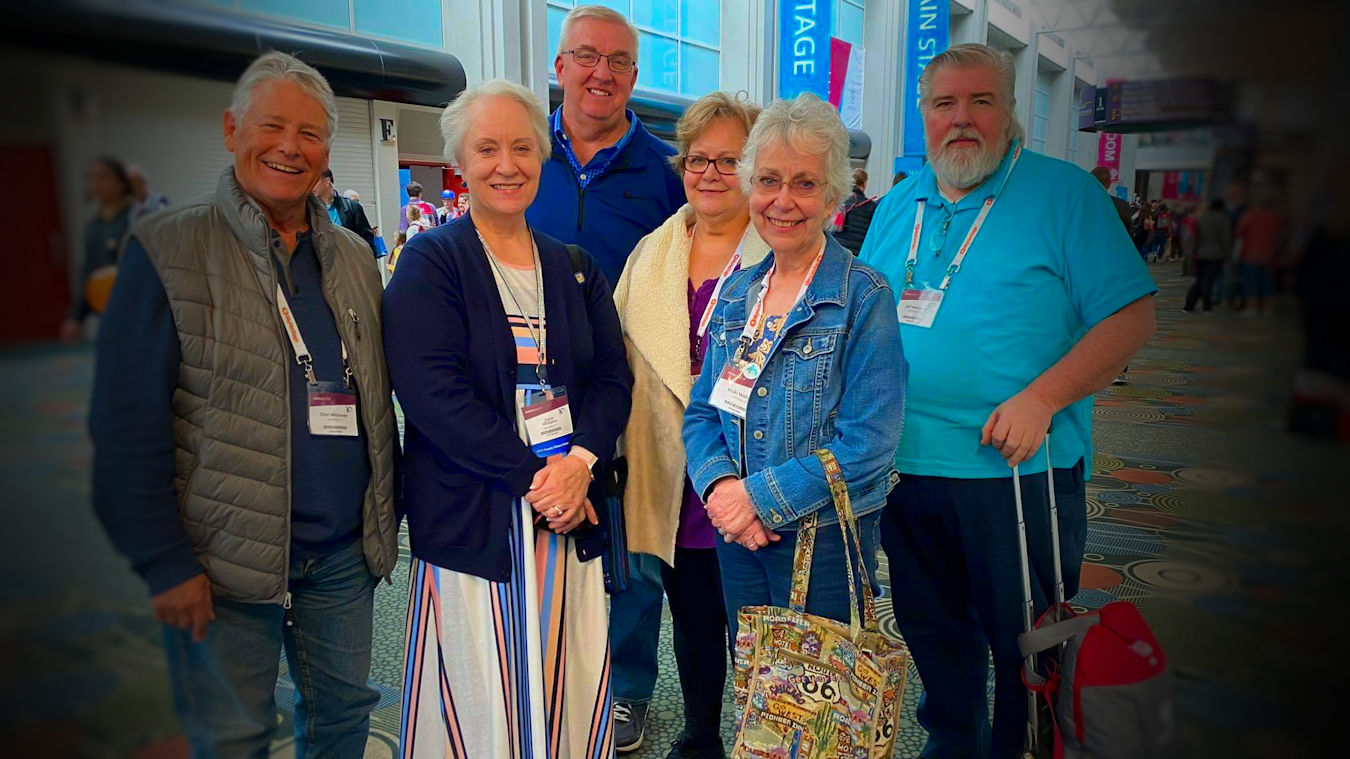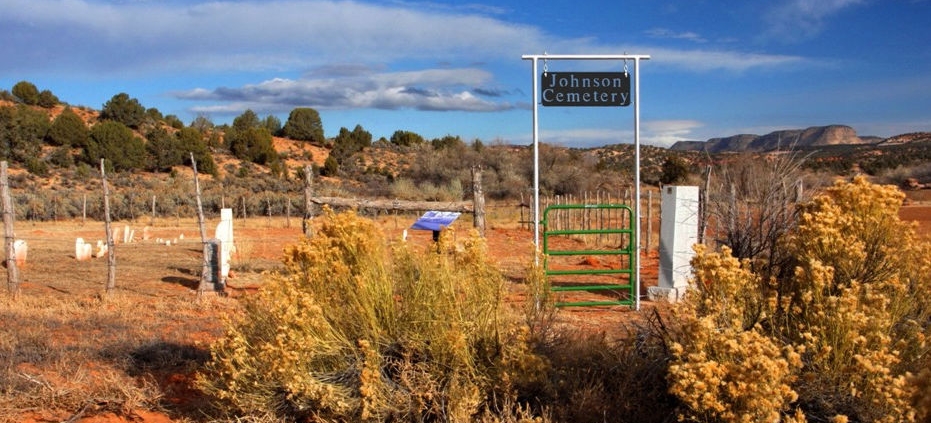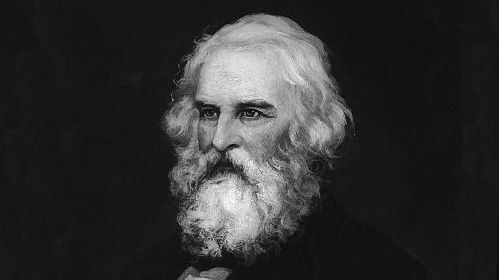Hannah and Her Sisters
As a father of six daughters who have all now grown to adulthood I can speak to the special society that sisters enjoy. I’ve seen it with my Grandma and her sisters, and with my own sisters, and with my wife and her sisters.
The stories from our family history below showcase this as well.
~ The Beals and the Westovers ~
Obediah and Rebecca Beal were married at the end of the American Revolution. They would go on to have a family of six children – five girls and a boy.
While Obediah and Rebecca were both born and raised in small communities near Massachusetts Bay their married life would take them towards a frontier in Vermont where all of their children were born.
Polly, Hannah, Sally and Daniel were all born in Bethel, Vermont.
In 1802, when Electa Beal was born, the family was further north in a village called Bristol.
Four years later a final daughter, named Laura, was born in Berkshire, Vermont – a tiny village on the U.S.-Canadian border.
This travelogue of the Beal family is significant because it puts them in very close proximity to the traveling Amos Westover family.
Amos and Ruth Westover, of Sheffield, Massachusetts, found themselves in Canada just beyond the border after the American Revolution.
Amos was looking for land and had followed a few of his older brothers in seeking a land grant from the King in Canada.
Between the years 1790 and 1811, Amos and Ruth moved their family several times – and had several children along the way – all within about 50 miles or so of the Beal family.
While there is no proof the families knew each other while in Vermont it is a fact that both the Beals and the Westovers ended up very close to each other in Ohio years later.
Electa Beal, daughter of Obediah and Rebecca, married Alexander Westover, son of Amos and Ruth, in Ohio in 1823. Daniel Beal, son of Obediah and Rebecca, married Olive Westover, Alexander’s little sister also in 1823, in Ohio.
The Beal and Westover families stayed settled in Ohio for the most part for about 20 years.
Obediah, Amos and Ruth all died and were buried there in 1822. Rebecca would live until 1844 and appears to have stayed near eldest daughter Polly for the rest of her life. Each of the Beal children married but were not far away from each other during these years.
When Electa’s husband Alexander unexpectedly died in 1834 she turned first to her family for help as she struggled with the family farm in Goshen and three young boys – Edwin, Charles and Oscar.
~ Conversion and the Trek West ~
Hannah Beal married a man named George Washington Brown in 1811. The Browns had two children, both daughters – Adeline and Sophia.
There was no small amount of trauma for Hannah during these years of the late 1830s and 1840s. Her daughter Adeline married in 1835 and made Hannah a grandmother in 1837. But within a few years both Hannah and Adeline lost their husbands.
In 1844, Hannah was taught by Mormon elders and converted, along with her daughter Adeline.
Hannah urged the elders to visit her family in neighboring counties. There they found a searching Electa, who at this time was trying to help her eldest son, Edwin, get through the death of his young wife and helping to care for her first grandchild.
When the decision was made to join the Saints in Utah, Hannah ventured west sometime between 1848 and 1850.
Perhaps she came at the insistence of her sister, Electa.
Electa and her boys and grandson were part of the large company that came west with Brigham Young in 1848.
By the early 1850 the records of Electa and Hannah clearly show them as being in Utah – Electa, in Salt Lake City, and Hannah out in Grantsville living with Adeline and her husband Aaron Sceva.
What records we can find confirm that “Aunt Hannah” was the family leader in Utah. Before Edwin and his families were called to the Cotton Mission in Southern Utah it was with Aunt Hannah where they were farming.
~ Living with Plural Marriage ~
We have accounted before how the years of 1856-57 were significant for the family during what is called the Mormon Reformation.
Plural marriage changed the lives not only of the men, but also of the Beal sisters who were grandmothers.
Hannah became the plural wife of Aaron Sceva – that’s right, her own daughter’s husband. This was actually not an unheard of arrangement. Church leaders frequently advised well-established men to marry widowed and unmarried women in order to help support them.
Electa Beal also took to marrying again during these years. Her new husband, like Hannah’s husband, was a prominent figure in their communities and within the Church. In 1849 she married Eleazar Miller, one of the men who had baptized Brigham Young way back in the 1830s.
Brigham, of course, knew all about the Westover family. In letters exchanged between Brigham and Eleazar in 1850 he inquired after “the new Mrs. Miller”. Electa, however, chose to stay close to her sons and never lived with Eleazar Miller. There is some indication as well that later Electa married a man named Chauncey Loveland – but as before, she never lived with him either.
~ Another Sister ~
Within 2 years another sister – the youngest of the Beal sisters, Laura Adaline Beal– would venture to Utah.
Laura’s story is a little unique. In 1844 when Rebecca Beal died she gave all she had to her youngest child, Laura.
When Laura was small child she suffered from an accident that put scissors through one eye, blinding her in that eye. Her history states that soon her other eye “faded in sympathy”, rendering Laura completely blind.
She would end up in a school for the blind from 1837 to 1844.
While there she was given a copy of the Bible published just for the blind, which took up several volumes and had become her prized possession.
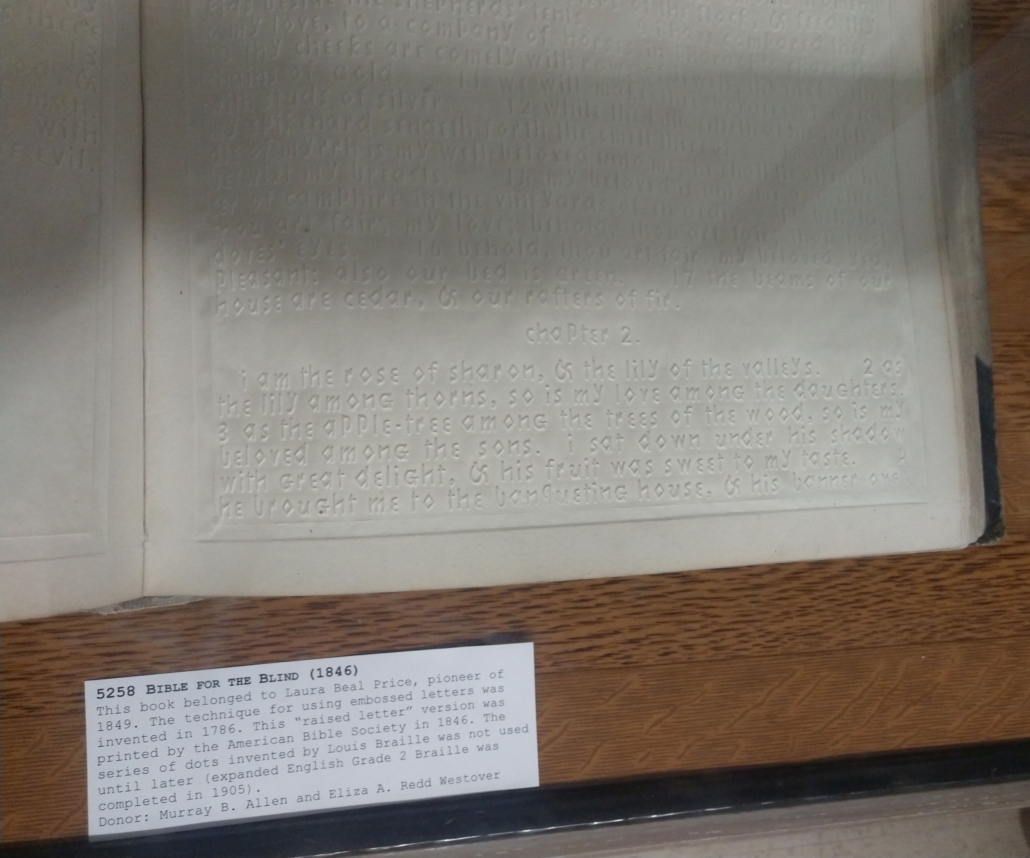
One of the volumes of Laura Beal’s Bible for the Blind now resides in the Daughters of Utah Pioneers Museum
It was not in Braille, as that had not been invented yet, but it featured large raised letters that could be read by touch.
The skill of reading with her hands was just the beginning of Laura’s many talents. She could sew, knit and create with her hands with legendary speed and dexterity.
Laura was also known for her spiritual sensitivities. Her love for the Bible and her ability to independently study it gave her amazing story-telling skills. Children later in life were reportedly spell bound by Laura’s retelling of Bible stories.
A missionary from Utah visited where Laura was living near Cincinnati in 1850, telling her that he knew her two sisters who had joined the Church and moved to Utah. His efforts to teach her the gospel were enough to get Laura to head west with him and his wife to Utah, even though she was not a member of the Church.
He continued his missionary efforts, drawing on Laura’s love of the Bible. While in route Laura fell ill but had enough faith to ask the elders for a blessing. She ended up requesting baptism while on her way west.
After arriving in Utah she became the plural wife of a man named John Price. It was not a good situation for her, however, and within two years she found herself in an abusive situation that had robbed her of the money given to her by her mother years before. On the advice of her Bishop, she contacted Brigham Young for a bill of divorcement, which was granted.
From there Laura headed to Grantsville to her sister Hannah’s home. It was there she began to build her legendary status as “Aunt Laura”.
From that point forward in her life Laura stayed with family she knew. For a while she was with Hannah, then she joined Electa in Southern Utah for a while. In later years, she lived with a daughter of Edwin’s in Hamblin, Utah where she eventually died and was buried.
Aunt Laura was noted for a couple of peculiarities. She was very independent and insisted on caring for herself and helping around the home. Most children were fascinated by her because of all she could do and how well she would engage them.
Laura’s history concedes to one “bad habit” Laura had picked up years before she came to Utah – she smoked a pipe. She battled for years to conquer the habit in efforts to keep the Word of Wisdom and her history notes she got it down to just a once-an-evening indulgence. Like everything she did this was done according to a well-established pattern. Frequently the children would be pressed into service to help her light the pipe.
Laura’s church activity was forever steady and when the St. George Temple was dedicated she was there, with her sister Electa as a fellow temple worker, and she participated in doing temple work for their family members back in Ohio.
Hannah, Electa, and Laura each had their individual stories of coming to Zion and working out the salvation for their loved ones. Each of them was faithful. Each of them was a powerful example and doggedly devoted to the family. They cared for each other and honored their parents.
Hannah is buried in Grantsville. Electa is in Washington City, near St. George. And Laura rests in the Hamblin cemetery.
Hello, Cousin
One of my favorite parts of Rootstech has been the development of the “Relatives Around Me” feature at FamilySearch.
The physical gathering of 30,000 family history enthusiasts in downtown Salt Lake City was bound to include a few relatives. But how to find and connect with them? Using cell phone technology and an enrollment process via FamilySearch they found a way to do it. Last year, which feels like a million years ago now, a few of us did get together and took the following picture:
Rootstech this year is entirely different. As of this writing, about a half million attendees are enrolled. Given that many people from around the world, how many relatives can be going through the Rootstech experience at the same time?
Well, they’ve adjusted the technology and we can see who is enrolled who we are related to. This year I can see that nearly 40,000 related to me are at Rootstech.
Obviously we cannot meet this year. But can we still connect? Well, I’m trying — one by one — to reach out to as many of my cousins out there as I can.
I’m introducing them first to the Edwin Westover Family Project.
While that is very important to me I feel the overall effort we’re making here on this website and at FamilySearch is more important. Somewhere in the closets of those 40,000 cousins could be a lot of great information. It could be pictures, it could be artifacts, it could be journals or whatever. We’d like to copy it all and archive here. I think among all those cousins is a bigger family story to be shared.
I want to meet you all, too.
The Edwin Project, which is simply a modern gathering of Edwin Ruthvin Westover’s descendents on Edwin’s 200th birthday, is a great way to meet so many of these cousins.
But let’s face it – Edwin is the low hanging fruit. I’d like to find more information about those generations who came before Edwin. We have a branch of the family in Canada, another in Missouri, more in Michigan and New York state. There are histories there from the 18th century we need to learn.
So when I am reaching out to cousins at Rootstech is not only relates to Edwin. I’m interested in all of you.
So don’t be shy. When I sent that message you may have seen at FamilySearch, it’s not just some weirdo you don’t know stalking you at RootsTech. It’s me. Your cousin! And yes, I’m a weirdo but only in the nicest possible terms and I just want to know you.
We have a tremendous shared heritage. I’m anxious to learn more of our story from wherever I can find it.
So if you have information, pictures, journals and family history stuff, please share. And I’ll share with you. That’s what we’re here for.
Colliding Family Histories
Note: I have always maintained that our efforts with this site are for my children and grandchildren. Little did I know that my married children’s spouses would be found to mingle with our Westover ancestors. This is another tale of family history coincidences, a principle I do not believe in.
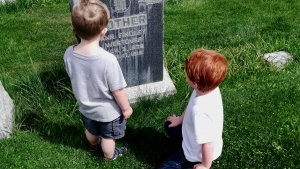 On a beautiful spring day this week I took my young grandsons, Damon and Jax, out for an afternoon ride to go see the flyover of jets being sent to Cache Valley in support of healthcare workers during the COVID-19 pandemic.
On a beautiful spring day this week I took my young grandsons, Damon and Jax, out for an afternoon ride to go see the flyover of jets being sent to Cache Valley in support of healthcare workers during the COVID-19 pandemic.
My goal was to position ourselves high on the west bench of the valley to be able to see the jets. So we drove out to Highway 30 just north of Mendon where I knew of a good spot. My goal was to see the jets and then take a little excursion just a few miles down the road to the Mendon City Cemetery, so the boys could see the graves of ancestors we have there.
We had a great time. These boys have been in my home now, with their parents and baby sister, for about six months. Although young – Damon is 7 and Jax is 4 – I felt it was a good opportunity to share some heritage with them.
Later that night, in discussing things with their mother, Angie, she shared that she is a descendent of Joel Hills Johnson, the man who penned the words to the hymn, High On The Mountain Top.
Coincidence #1: Angie is married to my son, Enoch. Joel Hills Johnson just happens to be the founder of Enoch, Utah. Funny, eh?
Intrigued, I looked up Joel Hills Johnson on Family Search.
Coincidence #2: The first thing I noted was that Joel was buried in Johnson Cemetery. Where had I seen that before? Well, that’s where Edwin Ruthven Westover is buried.
How many connections could he possibly have?
I have since spent several hours learning the story of Joel Hills Johnson. He has a prolific history, both in Utah and in the Church.
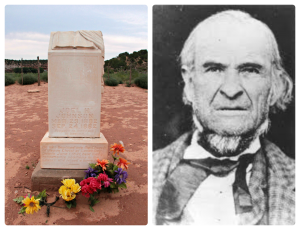 Joel H. Johnson was born on March 23, 1802, in Grafton, Massachusetts to Ezekiel Johnson and Julia Hills. He married Anna P. Johnson on November 22, 1826, and they had six children.
Joel H. Johnson was born on March 23, 1802, in Grafton, Massachusetts to Ezekiel Johnson and Julia Hills. He married Anna P. Johnson on November 22, 1826, and they had six children.
Around the year 1830, Joel sold his farm in Pomfret and moved to Amherst, Ohio. It was in Amherst where Joel was baptized a member of The Church of Jesus Christ of Latter-day Saints on June 1, 1831. Soon afterwards, he became president of the Church’s Amherst Branch. He met the Prophet Joseph in 1831. In 1832, he was called on a mission to New York.
In 1833, Joel moved to Kirtland, Ohio, where he operated a saw mill and furnished lumber to finish the temple. He went on another mission to both Ohio and Kentucky in 1835, and often preached and baptized in the vicinity of Kirtland. He attended the dedication of the Kirtland Temple.
In 1838 Joel helped organize the Kirtland Camp. He stopped at Springfield, Illinois, and did not continue to Missouri, but organized a branch in Springfield and became the first missionary to preach in Carthage, Illinois.
Coincidence #3: The date and location of Joel’s travels synchs with the dates and location of the Albert Smith family, who joined the church around this time near Springfield, Illinois.
Joel later had a large amount of success in baptizing families that lived along Crooked Creek, which was seven miles from Carthage. In April 1839 he organized these converts as the Crooked Creek Branch. After this, Joel directed his new converts in the forming of the town of Ramus (now Webster, Illinois). In February 1840 Joel moved to the area, where he purchased a sawmill. The Ramus Stake was organized on July 4, 1840, with Joel as president. Joel’s wife died in September 1840. He was here in Ramus when the Prophet Joseph and Hyrum were martyred in June 1844.
In 1846, mobs forced Joel to flee Ramus and moved to Knox County, Illinois. He later joined the Saints at Winter Quarters, Nebraska. Joel arrived in Salt Lake City on October 11, 1848. He crossed the plains in Willard Richards’ Company.
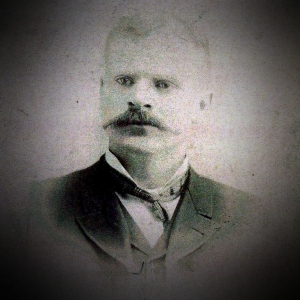 Coincidence #4: Also in the Willard Richards Company was David Rowe and family. Is it possible they knew each other?
Coincidence #4: Also in the Willard Richards Company was David Rowe and family. Is it possible they knew each other?
Yes.
From Joel’s own journal we read: “…I loaded my wagons and started on the 6th day of May, 1848 for the city of Great Salt Lake in Upper California I came to David Rowe’s in Fulton County the first night and on the 7th, David Rowe and his family started with me for the same place. My family consisted of myself and two women and six children. David Rowe’s family consisted of himself, wife, and four children. We came to Nauvoo where I stopped and visited with my friends. We then crossed over the river to Montrose and stopped with my brother Joseph one week, sheared my sheep, sold the wool, etc. We then started for Winter Quarters and had a very crooked and bad road and had to repair and build many bridges. We arrived at Winter Quarters the first week in June. Here we tarried four weeks, waiting for Doctor Richards and Amasa Lyman’s company.”
He served as a justice of the peace and as Bishop of the Mill Creek Ward. Joel built a saw mill from 1849 to 1851 at the mouth of Mill Creek Canyon.
As he made his wagon trips up and down the steep canyon, he often thought about the flag that had been planted on Ensign Peak. He knew he had safely made it down the mountain with his load when he turned north and headed for the tithing office. He always breathed easier when he could look up at that peak and see Old Glory waving.
In the early spring of 1850, Joel loaded up a load of prime lumber and headed for the tithing office. As he headed into the lot that housed this office, he noticed that there were several other wagon loads of tithing offerings ahead of him. He stopped his team, unhitched the horses and turned them into “Brother Brigham’s” pasture, and sat down to wait his turn to unload.
Being a warm spring day, Joel sought the shady side of his wagon, leaned back against the wheel and waited. As was his habit, he pulled out a piece of paper and prepared to write. He found himself thinking about the breeze and how it must be making ‘Old Glory’ ripple. In his mind he pictured how it must look there on the top of the peak under the clear blue sky as it waved and fluttered in the breeze. His mind painted such a wonderful picture.
Almost as if written by unseen hands, words began to appear on the paper:
High on the mountain top,
A banner is unfurled.
Ye nations now look up;
It waves to all the world.
In Deseret’s sweet, peaceful land-
On Zion’s mount behold it stand!
For God remembers still
His promise made of old
That He on Zion’s hill
Truth’s standard would unfold!
Her light should there attract the gaze
Of all the world in latter days.
His house shall there be reared
His glory to display
And people shall be heard
In distant lands to say
We’ll now go up and serve the Lord
Obey His truth, and learn His word.
For there we shall be taught
The law that will go forth,
With truth and wisdom fraught
To govern all the earth;
Forever there His ways we’ll tread
And save ourselves and all our dead.
Then hail to Deseret!
A refuge for the good,
And safety for the great,
If they but understood.
That God with plagues will shake the world
Till all its thrones shall down be hurled.
In Deseret doth truth
Rear up its royal head;
Though nations may oppose,
Still wider it shall spread;
Yes, truth and justice, love and grace,
In Deseret find ample place.
Joel finished his poem, folded up the paper, put it in his pocket, and went about the task of getting his lumber measured and recorded.
Sometime later he showed his poem to John Taylor, then a member of the Quorum of the Twelve. President Taylor liked the poem so much he asked if he could keep it.
In those days, words only were written down and then sung to familiar folk tunes. In just a short time it became one of the favorite songs where ever the Saints gathered
This poem was only one of about a thousand that Joel H. wrote. But it became one of his most recognized ones.
His poetry centered around four themes: His love and devotion to the gospel, his love of the Prophet Joseph Smith, his love of his family, and his desire to enjoy life, liberty, and the pursuit of happiness for himself and all other human beings.
In 1849 and 1850, Joel served in the Utah Territorial Legislature.
Joel was the founder of Enoch, Utah, settling there in 1851. When other settlers arrived in 1854, they built a fort which they named “Johnson’s Fort.” Before it became Enoch, it was named Elk Horn Springs. Joel later helped settle other areas in southern Utah. In 1853, he was appointed to serve as a missionary among the Piedes of Iron County, Utah. Joel recorded in his journal that he “made eleven different places.”
Joel was a polygamist and fathered several children from five wives. Joel maintained a journal in which was found the earliest source for the interpretation of “hot drinks” in the Word of Wisdom meaning coffee and tea. He recorded hearing the Prophet Joseph teach this principle.
In 1871, at the suggestion of Brigham Young, Joel and his brothers explored an area north and east of Kanab known as Spring Canyon. There they took up the challenge of building a settlement to “live the Order of Enoch”.
The Johnson families establish farms, a schoolhouse, a general store and even a post office. From 1871 until about the 1930s the tiny, out-of-the-way place was home to several families.
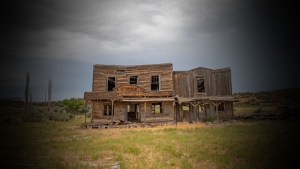 But due to it’s remote location and the scattering of the settlement’s later generations Johnson became a ghost town. It’s only other claim to fame came from the television series Gunsmoke, which ran from 1955 to 1975. The ghost town of Johnson was the set for the series.
But due to it’s remote location and the scattering of the settlement’s later generations Johnson became a ghost town. It’s only other claim to fame came from the television series Gunsmoke, which ran from 1955 to 1975. The ghost town of Johnson was the set for the series.
Coincidence #5: Another family that found their way to Johnson was that of Henrietta Bird Shumway, the third wife of Charles Shumway. They came from Mendon, Utah in Cache Valley. Charles Shumway was the father of Mary Eliza Shumway, the 2nd wife of Charles Westover, Edwin’s brother.
(Charles Shumway was also a founder of Manti, Utah and is frequently mentioned in the ward history there with both Albert Smith and Gardner Snow. The man got around to many lines in our ancestry!)
Henrietta’s biography recounts her experience upon arriving at the canyon: “The farm, unfenced and uncleared had never known a plough. The only shelter was a deserted trapper’s cabin, so small that when all the beds were made, Henrietta could scarcely walk between them to cook the meals.
All of those buried in the Johnson Cemetery died in the 19th century, including Edwin. It is noted that the Johnsons and the Shumway generations to follow intermarried a great deal and are buried in that cemetery.
According to Findagrave.com only 59 people are buried there – mostly Johnsons, Shumways, and Laws.
Joel Hills Johnson was well connected to Mormon leadership in the 19th Century. He knew the Prophet Joseph (and loved him immensely). He knew Brigham Young, John Taylor, Wilford Woodruff and Erastus Snow.
Coincidence #6: In fact, there is so much in his history I feel we could be finding connections to him all over the place. Curious to know if I might be related to him I dug a little deeper into his family lines. Sure enough, we’re connected back to the 17th century to a man named Nathaniel Heaton. He is my 10th great grandfather through the Snow/Roberts line. Nathaniel Heaton Joel H. Johnson’s 7th great grandfather.
Well, my grandchildren through Enoch and Angie are going to have a lot of work to do someday. Their Johnson family history runs strong in the blood. Angie also tells me she has other Danish ancestors with pioneer backgrounds in the Church.
I’m sure that’s no coincidence.

